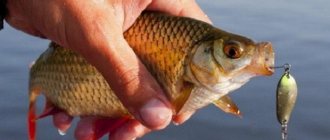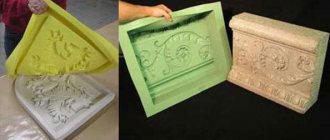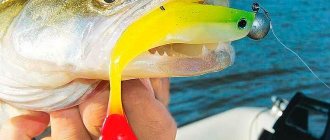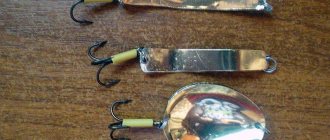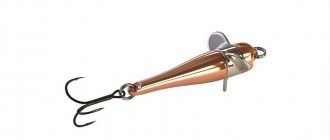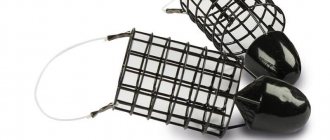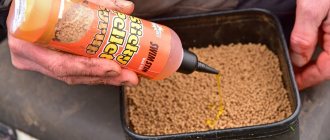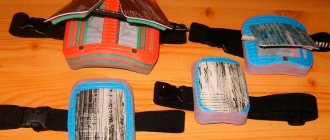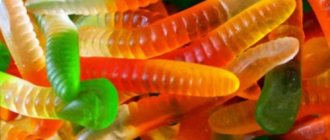Molds for casting silicone baits
You can buy molds for casting or make your own. As you can imagine, the mold consists of two parts that fit together to form a sealed area.
If you want to buy a ready-made mold for casting, then it’s easier for you to do this on the Internet, since online stores sell a large variety of all kinds of molds for casting silicone and other devices.
Shapes can be made from various materials and colors.
Several contours for several baits can be cut out in the molds at once, which speeds up casting.
Good casting molds should have air ducts that allow air to escape when the silicone is poured. The walls of the molds should fit tightly against each other.
Prices
Depending on what material the form is made of, its cost will vary significantly. For example, products made from gypsum are not of very high quality, and it is almost impossible to obtain a perfectly smooth shape; therefore, they will play much worse in water.
For these reasons, plaster molds are not too expensive - you can purchase them for 2-2.5 thousand rubles.
Tin molds or molds made of polymer materials have a perfectly smooth surface, which allows the final bait to be also very smooth. The cost of such forms will be much higher - in ordinary stores with fishing goods, its price can even reach 8-10 thousand rubles.
DIY mold for silicone baits

Most often, craftsmen make their own molds for casting from plaster, as it is inexpensive and quite simple. To make this mold you will need: plaster, water, dishes, lubricant, a sample of silicone bait. For more information about making plaster molds, watch the video.
How to make a mold for pouring silicone yourself?
The first thing to think about when making silicone baits at home is the pour mold, which can also be made at home. Such molds can mainly be made from the following materials:
- Gypsum;
- Plexiglas.
In order to start making a mold with your own hands at home, you will need to stock up on some equipment:
- Construction or dental plaster;
- Bowl for mixing plaster;
- Large spoon or spatula for stirring;
- Kitchen scales;
- Water;
- Soap, it is better to choose liquid;
- An example of the final product on which an impression will be made.
The dishes that will be used for mixing must be extremely clean and dry, without any plaster residues.
It is necessary to choose the right ratio of gypsum and water; it is recommended to stop at 25 ml of water and 100 gypsum. But it is necessary to pay special attention to the fact that the temperature of all components must be at least 20 degrees. In order for the gypsum to dissolve as much as possible in the water without lumps, it is necessary to slowly and carefully mix it into the water for 60 seconds. If bubbles suddenly appear, you urgently need to knock them out and get rid of them.
What you need to make silicone baits
- Silicone casting mold
- Silicone heating mold
- Microwave
- Fluoroplastic syringe
- Silicone Grease
- Clamp
- Gloves
- Scissors
- Silicone
- Sequins
- Dye
- Flavor
We've sorted out the casting molds, now let's move on to other tools. Ceramic, glass or fluoroplastic cups can be used as a container for heating silicone. Fluoroplastic is preferable, as it holds the temperature longer and is very durable.
Handle containers heated in the microwave using gloves or a cloth.
Glitter, dyes, flavors
Glitter is not necessary in silicone baits, but is desirable as its shine is similar to the shine of fish scales, making it more natural for predatory fish. Sequins come in different colors and sizes (from 1 to 6 mm).

Dyes (pigments) come in a variety of colors: black, white, red, green, blue, orange and others. Pigments are simple, photoluminescent and fluorescent. It is worth noting that to obtain the desired color, it is not necessary to buy all the colors, since to obtain the desired shade you can simply mix several different dyes.

As for flavors, special heat-resistant attractants are used that can withstand the temperature of molten silicone well.

In online stores you can find the following scents: fish oil, caviar, anise, garlic, coffee, caramel, lemon and others.
Forms for filling
The most accessible and easy-to-handle material for making a mold into which silicone will be poured is gypsum (construction or dental). The technology for creating a mold from gypsum is quite simple, so it is often used at home:
- You need to dilute the gypsum powder with water to the consistency of sour cream.
- Pour the prepared mixture into a suitable plastic or cardboard container.
- Place a sample of an artificial fish in plaster for about an hour and a half.
- Extract the prototype of the future silicone live bait from the frozen plaster mass. The mold is ready to be filled with silicone.
Disadvantages of gypsum matrices
The first disadvantage of gypsum molds is the long drying time. If you pour silicone into an under-dried mold, bubbles may form, spoiling the appearance of the finished bait.
The second disadvantage of gypsum matrices is the difficulty in imprinting small parts of artificial baits. The third negative property of such forms is their fragility. Fourthly, getting the finished product out of a gypsum blank is quite problematic.
Epoxy resin can eliminate the shortcomings of gypsum matrices. The finished plaster mold is lubricated with a thin layer of epoxy and left to dry thoroughly for a while. After this procedure, the walls of the mold become smooth, the risk of bubbles is reduced, and removal of the finished silicone bait from the mold is simplified. But as a result of such processing of the plaster mold, the size of the home-made silicone bait will decrease somewhat.
Syringes for casting silicone baits
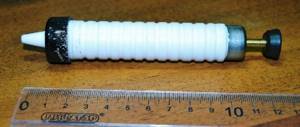
Ordinary plastic syringes are not used, as they immediately deteriorate from the temperature of liquid silicone. Glass syringes or special syringes made of fluoroplastic are used. Glass syringes are fragile and you need to be very careful with them. PTFE ones are more reliable.
It is worth noting that silicone can be melted in a separate container, or directly in a syringe. In a separate bowl, mix melted silicone, dyes, glitter and flavors. After stirring, the silicone must be heated before pouring.
If silicone melts in a syringe, then it should be placed in the microwave with the spout facing up. The nose of the syringe can be plugged with a toothpick or match to prevent the silicone from leaking out.
Silicone lure casting process
- Grease the mold with silicone grease.
- Clamp the mold with a clamp.
- You need to heat the silicone in the microwave at a power of 200-300 watts, stirring the silicone every 30 seconds until completely melted.
- Draw silicone into the syringe. If you heat the silicone in a separate container, you need to draw the silicone into the syringe. If the silicone melts in the syringe, move on to the next point.
- We turn the syringe upside down with the needle, pull the piston back a couple of centimeters, and then smoothly squeeze out all the air until liquid silicone flows out of the syringe.
- Take a mold for silicone baits, insert a syringe into the sprue and squeeze out the silicone until the silicone flows out of the air vents of the mold.
- After filling, slowly remove the syringe from the mold while continuing to squeeze out the silicone. This must be done so that the bait does not have hollow noses.
- Leave the whole thing for a minute until it cools.
- Remove the bait from the mold.
- After removing the silicone bait, you need to put it in cold water.
- Next, use scissors to cut off the excess silicone.
The bait is ready.
Materials for silicone baits
To make a silicone bait of the desired shape and size at home, the master will need two materials: silicone for making baits and plaster. The first will consist of the artificial bait itself, and the second is necessary in the manufacture of a matrix of the desired shape for silicone baits.
When making artificial fish at home, you can use either purchased silicone to make baits, or material obtained by melting down old baits that have become unusable. The second option is the most cost-effective, but will require a lot of time associated with the process of remelting the material.
Quite common materials for casting silicone baits in artisanal conditions are Pentaplast 710 and Pentaplast 718. Their prices are quite reasonable, but when they harden, the finished products shrink noticeably.
Budget types of silicone for DIY baits also include Elastolux (TV 25). It, unlike the first two, does not shrink significantly, and its low viscosity coefficient allows it to easily fill any elements of the bait’s shape (even miniature ones), which during subsequent coloring makes it possible to achieve maximum coincidence of the manufactured copy with the original.
If you need to get a high quality bait, then you should use thermoplastic. Silicone fish made from it will practically not be inferior in characteristics to production analogues. But in terms of price, such material will cost the fisherman more than others.
Melting old silicone baits
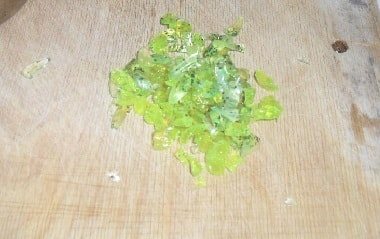
Before heating, they need to be cut into small pieces. Silicone is placed in the microwave at a power of 200-300 watts. From time to time you need to check the silicone and stir it until it becomes liquid.
If silicone is overheated, it begins to burn and change color, which is very bad. Burnt silicone begins to smell strongly and release substances harmful to the body.
Before each use, the mold must be lubricated with silicone grease.
Fumes from molten silicone are harmful to the body, so ventilate the room or work outside!!!
Casting silicone baits using Redbug molds
The Redbug company sells products for casting silicone baits. In their store they have molds for casting baits, silicone, glitter, dyes, flavors, fluoroplastic syringes, mixing containers and other auxiliary tools.
Particular attention should be paid to casting molds that are made of artificial stone. The quality of the molds is quite good; before each use they need to be lubricated with silicone grease. The assortment includes molds for casting both one and multiple baits. There are shapes of the most popular lures such as Keitech Swing Impact, Pontoon 21 Awaruna, Dexter Worm, Imakatsu Javastic and many others.
You can get acquainted with all Redbug products by following the link.
Author of the article: Vitaly Leonidovich Ivanov, 2021.
